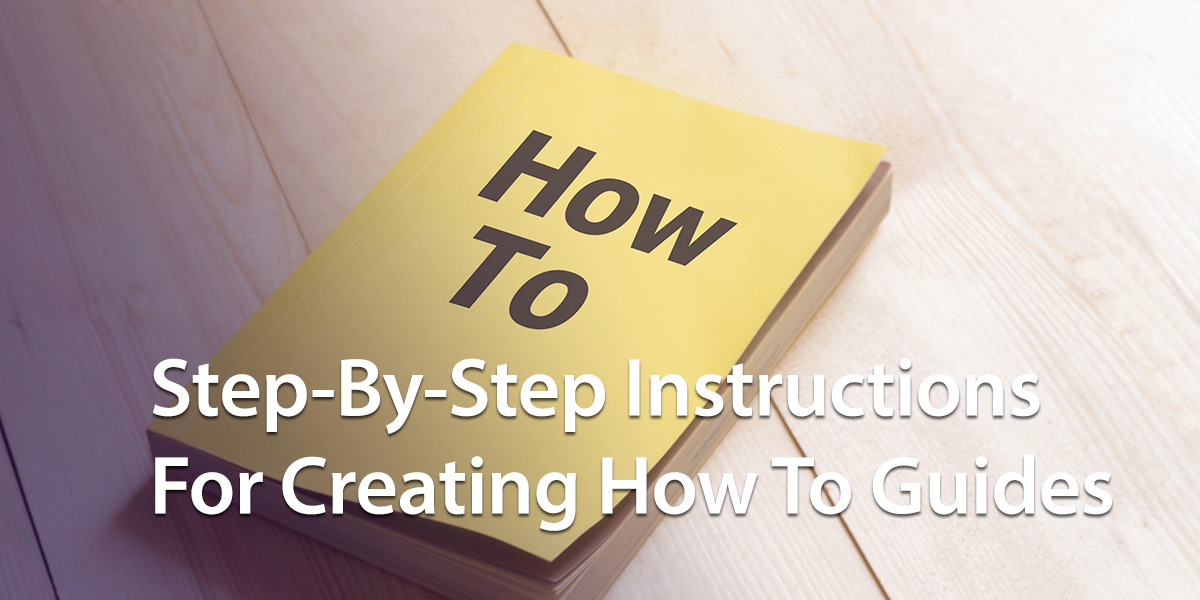Millions of people search “how to guides…” on Google or other search engines daily. These searches demonstrate a shared need: learning new skills and discovering how to do something. It could be developing the ultimate onboarding plan or making a tasty chicken curry for tonight’s dinner. A how to guide does what it says on the box. It provides clear, concise step-by-step instructions on how to perform a specific task or new process.
Creating a guide is one thing. However, writing effective how-to guides is something else. Today’s post explores all the details. We examine why how-tos are so important and explore the steps involved in writing a guide. Finally, we share our top tips and some best practice examples.
What Is A How To Guide?
You name it: there’s a how to guide out there for pretty much any task, from home improvement and gardening to technology and communication. How-to guides make it easy for people to understand how things work and learn a new skill.
The best how-to guides offer concise instructions pitched perfectly at the target audience. It could be anything from straightforward internal processes to complex tasks. Effective how-to guides create actionable steps and walk people through what they need to know.
How-tos can help businesses by providing customers with 24/7/365 access to help, improving overall customer satisfaction. And happy customers are gold when it comes to spreading the word about your product or service.
How-to guides are also excellent knowledge-sharing tools. They streamline onboarding, helping new hires get up to speed with processes and minimizing the likelihood of costly mistakes. They also support staff in sharing institutional knowledge and developing their skills and expertise.
The bottom line is that an effective how-to guide makes life easier for your customers and employees.
Why Are How To Guides Important?
A how-to guide provides valuable information on various tasks both complex and basic. And they offer many benefits. Let’s take a look at the headlines:
Provide Quick Solutions To Common Queries
Many of your customers and staff use search engines to learn how to do something. How-to guides are a convenient way to explain the steps of a process and solve problems or pain points.
Train And Onboard New Employees
By using guides in your onboarding process, you can help new hires learn your tools and procedures — without spending too much time on training. A knowledge base with user-friendly how-tos will improve employee engagement, satisfaction, and productivity.
You can also combine your guides to create manuals or use them as training aids that all employees can access.
Improve Customer Satisfaction
Increasingly, customers want and expect self-service options. Analyze customer feedback and support tickets to understand common pain points and then write a how-to guide addressing those issues.
Creating a knowledge base of relevant information that customers can access out of hours will improve overall customer satisfaction.
Grow Your Brand
Whether targeting new customers or growing your brand, a how-to guide helps you better connect with your target audience. You can demonstrate your expertise, provide relevant content, grow your mailing list, and generate more leads.
What Is The Format Of A How-To Guide?
Regardless of the learning process involved, there are several common elements to include in your guide.
Logical Sequence
All the best guides contain step-by-step written instructions organized in a logical, clear structure. Often, numbered lists set out the specific tasks. Readers complete tasks before progressing to the next step.
Easy-To-Follow Instructions
How-tos use a simple writing style where jargon is kept to a minimum. Concise instructions break tasks into manageable chunks so readers understand what’s required.
Visual Aids And How-To Guide Examples
Visual content helps to illustrate the step-by-step guide. As the old saying goes, a picture speaks a thousand words, so add images to provide more context and make instructions clearer.
Furthermore, look to include real-world examples. Relatable examples help improve the reader’s comprehension.
6 Key Steps For Creating Effective How-To Guides
Now it’s time to get down to the business of creating how-to guides. The following detailed instructions will help you create effective how-to guides every time, regardless of the particular task.
1. Understand Your Target Audience
Before you can begin writing, it’s essential to understand your target audience. Ask yourself the following questions:
- Who are they?
- What do they need to know already?
- What more would they like to know?
- What is their skill level – beginner or advanced?
Start by checking out online forums like Quora to find out more about your audience’s issues and challenges. Furthermore, gather feedback from your team and customers about the top concerns.
Understanding the target audience will help you create content that speaks directly to them and adds value.
2. Research The Topic
Even if you’re an expert on the subject, it pays to do some research. After all, you don’t want to make assumptions about what you need to cover. And your techniques and knowledge may need updating.
Check out other how-tos, watch explainer videos, and seek expert opinions. Furthermore, before you start writing, practice doing the task to refresh your memory.
3. Identify Actionable Steps
Now that you fully understand the process, it’s time to identify the key steps. First, consider the number of steps needed and assign a title to each. Next, write your instructions for each step using clear, simple language.
Ask a team member to review how actionable the steps are. For example, in step 2 above, we didn’t just say, “Do some research.” We also offered suggestions on how to complete the task.
4. Create An Outline
You are now ready to begin putting your how-to guide together. Here’s a sample outline to help guide you:
Introduction
Set the context by answering readers’ how, what, and why questions. You may also include company background information.
Goal
Be clear about what you want the how-to guide to achieve and how it will help the reader.
Step-by-step Instruction
This section is the nuts and bolts of your guide. Provide clear instructions for each step, and remember to add visual aids.
Resources
Include any additional information or links to further resources for those readers who want to dive deeper into the topic.
FAQs
Anticipate readers’ frequently asked questions and give them a succinct answer.
5. Add Visuals, Videos, And Relevant Links
Text-heavy documents can be hard work. So, mix things up with carefully chosen visuals to illustrate your key messages. It’ll make the steps more digestible and relatable and bring the how-to guide to life. Possible options include the following:
- Screenshots – essential if your how-to guide is about software adoption
- Tables
- Infographics
- Walk-through videos
- Diagrams
- Charts
- Images
Finally, include any additional information or links to other resources. Your readers may want to explore the subject further. Be sure to mention the source, as this is a valuable way to build trust and authority with readers.
6. Review And Publish
The final task before publishing your how-to guide is to review the content. Is it easy to read and simple to follow? Get a colleague, friend, or subject matter expert to go through the guide and ensure it hits the spot.
It’s time to publish once you’re happy with the final product. Share the how-to guide in a blog post, on social media, or your website. Add it to your company knowledge base and send it directly to users or customers.
Top Tips For Creating The Best How-To Guide
Here are some bonus tips to guide you in the writing process.
Keep It Short And Sweet
The golden rule when writing your how-to guide is to keep it simple and brief. Try to stay on point and focus only on the process or task. Avoid complex language and instead use an everyday conversational tone. Readers relate better to simple language.
Use An Active Voice
Try to avoid using a passive voice and instead write using active verbs. An active voice makes your writing more concise, direct, and easily understood.
Here’s a passive example:
- A new product line will be launched by the company next month.
And here’s the same sentence written using active verbs:
- The company will launch a new product line next month.
See the difference it makes?
Think About Formatting
Formatting is crucial to improving comprehension. Headings, bullet points, and numbered lists are great ways to break up text and help to guide readers. However, ensure they are applied at a consistent level.
Proofread
Typos and spelling mistakes are distracting at the best of times. However, an error in your instructional content could be critical. Thoroughly proofread your how-to guide to ensure accuracy. Better still, get a knowledgeable colleague to review the content.
Enable Collaboration
Things change. Even the best how-to guide will need to be updated. Gather feedback from readers and collaborate with team members close to the topic to ensure the guide stays current.
Best Practice How-To Guide Examples
If you’re still looking for inspiration to get started, here are some best practice examples to kickstart the process.
HubSpot’s How To Create An Editorial Calendar is an excellent example of what to do. It tells the reader everything they need to know to create an editorial calendar. And the guide includes lots of visuals, examples, and downloadable templates.
Yoast has a wealth of resources on search engine optimization. The subject matter may be highly technical. However, Yoast does a fantastic job of simplifying the complex. Check out Backlink Audit: Step-By-Step Guide Plus 12 Metrics To Check. The step-by-step guide breaks down the topic into bite-sized chunks, and helpful screenshots show readers exactly what they need to do.
And if you’re looking for a delicious breakfast treat tomorrow, how about Simply Recipe’s How To Make An Omelette? The easy-to-follow instructions will see you create the perfect omelet every time. As an added bonus, there are tips on the perfect omelet pan and some tasty ideas for fillings.
How-To-Write A How-To Guide: Quick Summary
- We’ve covered a lot of ground, so here’s a handy summary:
- A how-to guide sets out instructions on completing a task or process.
- They are surefire ways to offer solutions to customers and build your brand.
- How-to guides are excellent organizational knowledge-sharing tools.
- Create an effective how-to guide by:
- Understanding your target audience
- Researching the topic
- Identifying actionable steps
- Developing an outline
- Adding visuals
All that’s left for you is to get started on your how-to guide.
Additional Resources
Grammarly: A Guide To Writing Plain Language In Writing
United States Government: Federal Plain Language Guidelines
About MyHub
We are a leading provider of cloud-hosted intranet platforms. Our beautifully designed, easy-to-use software is consistently rated highly on independent review sites. Explore how MyHub can streamline communication, boost collaboration, and drive productivity with a free demo or 14-day trial.











0 Comments